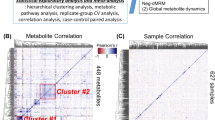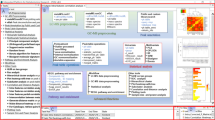Abstract
In this paper, we describe data processing and metabolite identification approaches which lead to a rapid and semi-automated interpretation of metabolomics experiments. Data from metabolite fingerprinting using LC-ESI-Q-TOF/MS were processed with several open-source software packages, including XCMS and CAMERA to detect features and group features into compound spectra. Next, we describe the automatic scheduling of tandem mass spectrometry (MS) acquisitions to acquire a large number of MS/MS spectra, and the subsequent processing and computer-assisted annotation towards identification using the R packages MetShot, Rdisop, and the MetFusion application. We also implement a simple retention time prediction model using predicted lipophilicity logD, which predicts retention times within 42 s (6 min gradient) for most compounds in our setup. We putatively identified 44 common metabolites including several amino acids and phospholipids at metabolomics standards initiative (MSI) levels two and three and confirmed the majority of them by comparison with authentic standards at MSI level one. To aid both data integration within and data sharing between laboratories, we integrated data from two labs and mapped retention times between the chromatographic systems. Despite the different MS instrumentation and different chromatographic gradient programs, the mapped retention times agree within 26 s (20 min gradient) for 90 % of the mapped features.

Workflow for the rapid processing and annotation of untargeted mass spectrometry data



Similar content being viewed by others
References
Lei Z, Huhman DV, Sumner LW (2011) Mass spectrometry strategies in metabolomics. J Biol Chem 286:25435–25442
Roux A, Lison D, Junot C et al (2011) Applications of liquid chromatography coupled to mass spectrometry-based metabolomics in clinical chemistry and toxicology: a review. Clin Biochem 44:119–135
Jones DP, Park Y, Ziegler TR (2012) Nutritional metabolomics: progress in addressing complexity in diet and health. Annu Rev Nutr 32:183–202
Holmer-Jensen J, Hartvigsen ML, Mortensen LS et al (2012) Acute differential effects of milk-derived dietary proteins on postprandial lipaemia in obese non-diabetic subjects. Eur J Clin Nutr 66:32–38
Sumner L, Amberg A, Barrett D et al (2007) Proposed minimum reporting standards for chemical analysis. Metabolomics 3:211–221
Vaughan AA, Dunn WB, Allwood JW et al (2012) Liquid chromatography–mass spectrometry calibration transfer and metabolomics data fusion. Anal Chem 84:9848–9857
Dunn WB, Erban A, Weber RJM et al (2013) Mass appeal: metabolite identification in mass spectrometry-focused untargeted metabolomics. Metabolomics 9:44–66
Creek DJ, Jankevics A, Breitling R et al (2011) Toward global metabolomics analysis with hydrophilic interaction liquid chromatography–mass spectrometry: improved metabolite identification by retention time prediction. Anal Chem 83:8703–8710
Menikarachchi LC, Cawley S, Hill DW et al (2012) MolFind: a software package enabling HPLC/MS-based identification of unknown chemical structures. Anal Chem 84:9388–9394
Hall LM, Hall LH, Kertesz TM et al (2012) Development of Ecom50 and retention index models for nontargeted metabolomics: identification of 1,3-dicyclohexylurea in human serum by HPLC/mass spectrometry. J Chem Inf Model 52:1222–1237
Boswell PG, Schellenberg JR, Carr PW et al (2011) Easy and accurate high-performance liquid chromatography retention prediction with different gradients, flow rates, and instruments by back-calculation of gradient and flow rate profiles. J Chromatogr A 1218:6742–6749
Boswell PG, Schellenberg JR, Carr PW et al (2011) A study on retention “projection” as a supplementary means for compound identification by liquid chromatography–mass spectrometry capable of predicting retention with different gradients, flow rates, and instruments. J Chromatogr A 1218:6732–6741
Neumann S, Thum A, Böttcher C (2013) Nearline acquisition and processing of liquid chromatography–tandem mass spectrometry data. Metabolomics 9:84–91
Horai H, Arita M, Kanaya S et al (2010) MassBank: a public repository for sharing mass spectral data for life sciences. Eur J Mass Spectrom 45:703–714
Smith C, Maille G, Want E et al (2005) METLIN: a metabolite mass spectral database. Ther Drug Monit 27:747–751
Wishart DS, Knox C, Guo AC et al (2009) HMDB: a knowledgebase for the human metabolome. Nucleic Acids Res 37:D603–D610
Wolf S, Schmidt S, Müller-Hannemann M et al (2010) In silico fragmentation for computer assisted identification of metabolite mass spectra. BMC Bioinf 11:148
Williams AJ (2011) Chemspider: a platform for crowdsourced collaboration to curate data derived from public compound databases. In: Ekins S, Hupcey MAZ, Williams AJ (eds) Collaborative computational technologies for biomedical research. Wiley, New York, pp 363–386
Kanehisa M, Goto S, Sato Y et al (2012) KEGG for integration and interpretation of large-scale molecular data sets. Nucleic Acids Res 40:D109–D114
Bolton EE, Wang Y, Thiessen PA et al (2008) Chapter 12 PubChem: integrated platform of small molecules and biological activities. In: Wheeler RA, Spellmeyer DC (eds) Annual reports in computational chemistry. Elsevier, Amsterdam, pp. 217–241
Gerlich M, Neumann S (2013) MetFusion: integration of compound identification strategies. J Mass Spectrom 48:291–298
Pete MJ, Exton JH (1996) Purification of a lysophospholipase from bovine brain that selectively deacylates arachidonoyl-substituted lysophosphatidylcholine. J Biol Chem 271:18114–18121
BD Biosciences (2013) Mammalian liver cytosol—guidelines for use (TF000016 Rev 1.0)
Nelson AC, Huang W, Moody DE (2001) Variables in human liver microsome preparation: impact on the kinetics of l-α-acetylmethadol (LAAM) N-demethylation and dextromethorphan O-demethylation. Drug Metab Dispos 29:319–325
Gürdeniz G, Kristensen M, Skov T et al (2012) The effect of LC-MS data preprocessing methods on the selection of plasma biomarkers in fed vs. fasted rats. Metabolites 2:77–99
Tautenhahn R, Böttcher C, Neumann S (2008) Highly sensitive feature detection for high resolution LC/MS. BMC Bioinf 9:504
Venables WN, Ripley BD (2002) Modern applied statistics with S. Springer, New York
Böcker S, Letzel M, Lipták Z et al (2006) Decomposing metabolomic isotope patterns. In: Bücher P, Moret B (eds) Algorithms in bioinformatics. Springer, Berlin, pp. 12–23
Cao Y, Charisi A, Cheng L-C et al (2008) ChemmineR: a compound mining framework for R. Bioinformatics 24:1733–1734
Scheder R (2007) monoProc: strictly monotone smoothing procedure
Kind T, Fiehn O (2006) Metabolomic database annotations via query of elemental compositions: mass accuracy is insufficient even at less than 1 ppm. BMC Bioinf 7:234
Tihanyi K, Vastag M (2011) Solubility, delivery and ADME problems of drugs and drug-candidates. Bentham Science Publishers, Sharjah
Croset M, Brossard N, Polette A et al (2000) Characterization of plasma unsaturated lysophosphatidylcholines in human and rat. Biochem J 345:61–67
Creer M, Gross R (1985) Separation of isomeric lysophospholipids by reverse phase HPLC. Lipids 20:922–928
Acknowledgments
We thank Christoph Böttcher and Stefan Schmidt for the mass spectrometry support in Halle and Carsten Kuhl and Sebastian Wolf for help with the data analysis and the CAMERA and MetFrag tools. Jens Holmer-Jensen and Kjeld Hermansen are thanked for providing the sample set used for isotope pattern analyses. The work by JS was supported by the Nordic Centre of Excellence (NCoE) program (systems biology in controlled dietary interventions and cohort studies (SYSDIET), P No., 070014) and the Danish Obesity Research Centre (DanORC; see www.danorc.dk). DanORC is supported by the Danish Council for Strategic Research (Grant No. 2101-06-0005).
Author information
Authors and Affiliations
Corresponding author
Additional information
Published in the topical collection Metabolomics and Metabolite Profiling with guest editors Rainer Schuhmacher, Rudolf Krska, Roy Goodacre, and Wolfram Weckwerth.
Rights and permissions
About this article
Cite this article
Stanstrup, J., Gerlich, M., Dragsted, L.O. et al. Metabolite profiling and beyond: approaches for the rapid processing and annotation of human blood serum mass spectrometry data. Anal Bioanal Chem 405, 5037–5048 (2013). https://doi.org/10.1007/s00216-013-6954-6
Received:
Revised:
Accepted:
Published:
Issue Date:
DOI: https://doi.org/10.1007/s00216-013-6954-6




